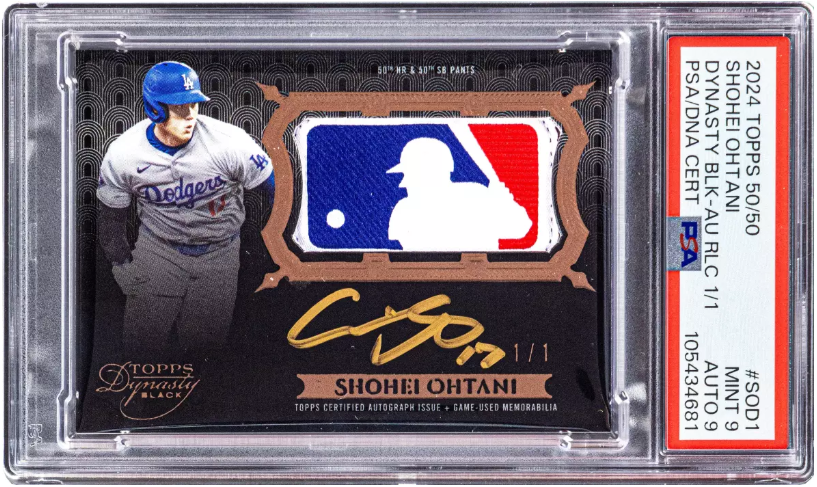Imagine the atmosphere in a packed auction room, teeming with the kind of intensity usually reserved for high-stakes poker games. Yet, in this instance, the valuable cargo being bid upon isn’t a priceless painting or a rare antiquity. Shockingly, it’s a small scrap of fabric. But not just any scrap — we’re talking about a piece of Shohei Ohtani’s game-worn pants, which recently turned heads by fetching a mind-boggling $1.07 million at Heritage Auctions. Yes, you read that right. A million dollars for pants, leaving many of us wondering if there’s something magical woven into the seams that we mere mortals can’t see.
The pants in question aren’t just any pair; they hail from a momentous game that etched Ohtani’s name in the annals of MLB history. It was during this game, pitting the Los Angeles Dodgers against the Miami Marlins, that Ohtani became the first player ever to hit 50 home runs and steal 50 bases in a single season. The rarity of this feat has made these trousers anything but ordinary. To be exact, this particular Topps Dynasty Black card, featuring a piece of the prized pants alongside Ohtani’s autograph in shimmering gold ink, represents far more than a simple sports collectible. It’s a gateway to a moment of pure athletic magic.
Breaking past records and wallets alike, this sale shattered the previous high-water mark for Ohtani memorabilia — a half-million-dollar rookie card from 2018. While most trading card enthusiasts obsess over rookie years, this deal proved that extraordinary feats can generate just as much buzz as formative years. Indeed, the sash of authenticity stitched onto this piece of memorabilia seems to have switched the interest from Ohtani’s lithe legs to his momentous deeds.
But let’s delve deeper. Why the fervor for a scrap of pants, you might ask? Chris Ivy, the sports auction maestro from Heritage, hit the nail on the head, describing Ohtani as “baseball’s biggest rockstar.” The allure lies in capturing historical moments fused with tangible memorabilia, not to mention the added allure of an official MLB logo patch. Such features transform a standard card into an opulent artifact, appealing to the fervent hearts and cavernous pockets of avid collectors. Just imagine that elegant gold signature glistening over a breakfast table or flanked alongside other cherished artifacts in a fan-grotto of Ohtani memorabilia.
In terms of memorabilia, enthusiasts had more than just one chance to hit a home run at the auction. Topps, the renowned trading card company, had the foresight to immortalize Ohtani’s feat with a series of three distinct cards. One notable version included segments of his batting gloves alongside another snippet from the same venerated pair of pants, selling for $173,240 earlier in the year. This goes to show that the true value isn’t necessarily in the pants themselves but in the stories they embody — the glorious achievements of an athletic marvel.
It’s noteworthy to mention that just earlier this month, a rookie card for Pirates pitcher Paul Skenes commanded an unbelievable $1.11 million. However, it’s hard not to facetiously ponder, “But where were his pants in all this?” The data suggests that while rookie cards have dominated the market, integrating personal paraphernalia into trading cards has clearly ignited imaginations.
Reflecting on the moment itself, Ohtani stood poised at LoanDepot Park with 48 home runs and 49 stolen bases already under his belt. By the second inning, the bases had been swiped for the 50th and 51st times that season, setting the stage for what followed. When the seventh inning rolled around, Ohtani faced off against Marlins reliever Mike Baumann and transformed a lazy curveball into a souvenir moon-shot, selling later for an astonishing $4.39 million, proving there’s no end to collector’s appetites for a slice of storied greatness.
But as remarkable as these stories are, one can’t help but wonder what could possibly be next. Could it be that future auctions will spotlight Ohtani memorabilia drawn from the unlikeliest of origins? After all, with collectibles like batting gloves and pants garnering such fervent attention, could shoelaces, socks, or even chewing gum wrappers make their debut on the auction block? Perhaps.
As we look to the future of sports memorabilia, it would seem the possibilities are as expansive as our imaginations. In this world of tangible sports history, prepared to be swept off your feet — or, if you’re fortunate enough to part ways with a few million dollars, get your hands on Shohei Ohtani’s trousers.





